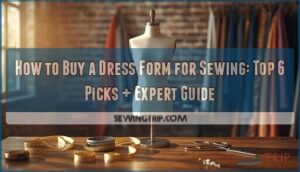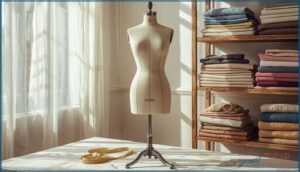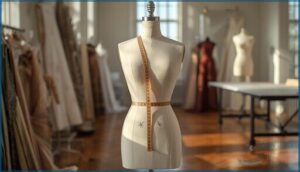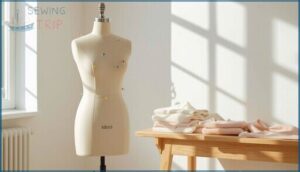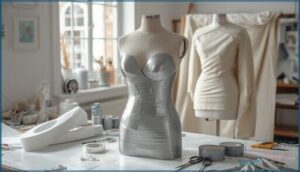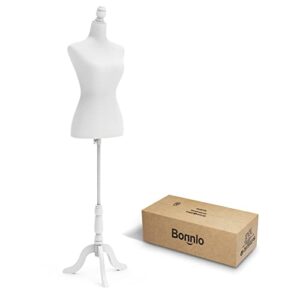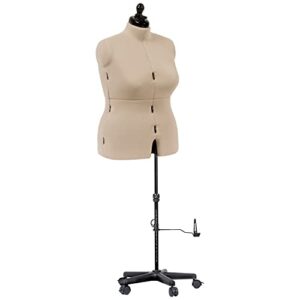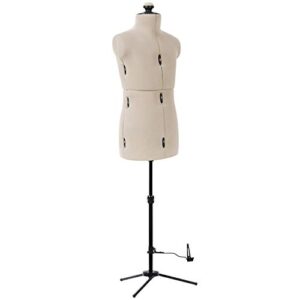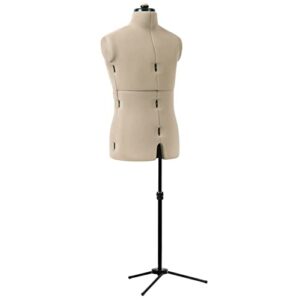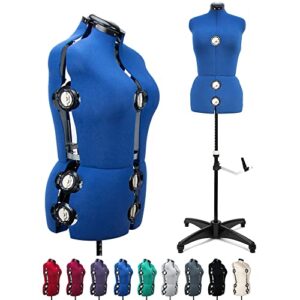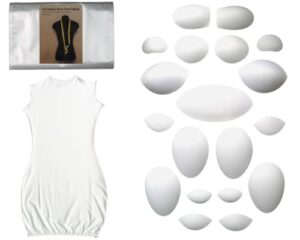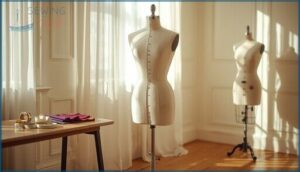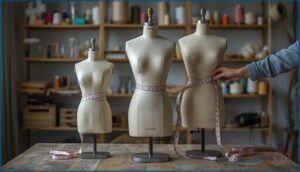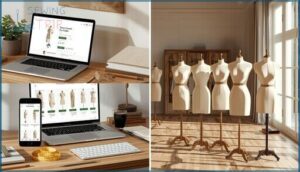This site is supported by our readers. We may earn a commission, at no cost to you, if you purchase through links.
Your first draping session with a makeshift alternative—a hanger, a pillow, maybe even a reluctant friend—makes one thing painfully clear: precision garment construction demands a proper three-dimensional form. Without accurate body proportions at your fingertips, you’re stuck with endless try-ons, frustrating adjustments, and seams that somehow never sit quite right.
A quality dress form transforms your sewing space into a professional fitting room, letting you pin, drape, and perfect garments with the same confidence as seasoned couturiers.
The market offers everything from budget-friendly adjustable models to custom-molded replicas of your exact measurements, but selecting the right option means understanding construction standards, sizing systems, and which features actually earn their price tag versus marketing fluff.
Table Of Contents
Key Takeaways
- Dress forms span five main categories—adjustable, professional, custom, foam, and DIY—with adjustable models ($150–$200) covering 2–3 clothing sizes through dial systems, while custom forms ($1,300–$6,000) replicate exact body measurements via 3D scanning for precision tailoring.
- Professional-grade forms combine fiberglass cores with polyurethane foam and canvas covers to withstand heavy pinning and repeated use, while collapsible shoulders and detachable arms enable fitting tight garments without stressing seams.
- Accurate dress form selection demands matching at least eight body measurements (bust, underbust, waist, hip, back length, neck, shoulders, height) to sizing charts, with adjustable ranges typically spanning 33–48″ bust across small/medium to medium/large models.
- Beyond the base form investment, strategic padding kits ($30–$40 for 19-piece systems) transform a single mannequin to fit multiple client body types across sizes 8–20, eliminating the need to purchase separate forms for each project.
Types of Dress Forms for Sewing
Choosing the right dress form starts with understanding what’s actually out there. The market offers several distinct categories, each engineered for different sewing needs and skill levels.
Let’s break down the five main types you’ll encounter so you can zero in on what works for your projects.
Adjustable Dress Forms
Adjustable dress forms are the chameleon of sewing tools—dial in your exact proportions across bust, waist, and hips with 12 or more adjustment wheels. Here’s what makes them game-changing for dressmaking and fabric draping:
- Flexible sizing: Most cover 2–3 clothing sizes on a single form fitting body proportions from 33–41 inch bust ranges
- Budget-friendly entry: Generally priced $150–200, far below professional dress forms
- Height flexibility: Tripod stands adjust for accurate hemming and proportion checks
- Expandable panels: Front, side, and back dials reshape the torso for custom form fitting
Perfect for home sewists testing sewing mannequins before committing to fixed industrial models. When choosing a dress form, consider the benefits of custom made forms to guarantee the best fit for your sewing needs.
Professional Dress Forms
When you’re ready to level up from adjustable models, professional dress forms deliver precision you can pin your reputation on. Built with fiberglass cores wrapped in pinnable felt and canvas—Dress Form Materials engineered for durability—these Sewing Mannequins anchor your Fashion Design work with industrial-grade stability.
Expect collapsible shoulders, detachable arms, and anthropometric accuracy drawn from body-scan data. Professional Fittings demand this investment: forms run $389–$499, reflecting the Sewing Techniques and Garment Display standards that separate hobbyists from designers.
The growing demand for high-quality dress forms is driven by the increasing need for visually appealing displays in the fashion industry.
Custom Dress Forms
Professional Dress Forms meet most needs, but your body deserves an exact replica. Custom Sizes created through 3D Body Scanning start around $1,300—capturing hundreds of thousands of data points to eliminate guesswork.
These Tailored Sewing Solutions use Custom Fit Technology and Precision Measurements that adjustable Sewing Mannequins can’t match. You’ll invest $3,775–$6,000 for full-body Tailor Dress Forms, but the fit advantage transforms challenging projects into confident wins.
Foam Dress Forms
High-Density Foam Dress Forms deliver superior Sewing Precision through fully Pinnable Surfaces—you can insert pins at any angle across the entire torso.
Professional Dress Forms built from polyurethane foam cores weigh under fifteen pounds yet stay stable, and Foam Customization lets you carve or pad the shape to mirror your exact proportions.
Sewing Mannequins with jersey covers require minimal Dress Form Maintenance while supporting complex draping tasks that adjustable models can’t handle.
DIY Dress Forms
Building your own Dress Form from duct tape and Paper Mache slashes costs to under forty dollars—far below commercial Sewing Forms that start around one hundred fifty.
- Tape Measurements: Duct tape or water-activated kraft paper creates your shell, capturing your exact proportions for precise Dressmaking and DIY Fashion projects.
- Foam Filling: Expanding foam hardens the core, though you’ll need careful application to prevent bulging during Body Casting.
- Fabric Covering: A jersey layer over the form provides smooth pinning surfaces for professional Sewing work.
Top 6 Dress Forms for Sewing
You’ve got options regarding choosing the right dress form for your sewing space. Whether you’re fitting garments for yourself, your kids, or clients with different body types, there’s a form built to match your needs.
Here are six standout picks that deliver professional results without breaking the bank.
1. Adjustable Female Dress Form Mannequin
When you’re draping fabric and need every measurement to shift with your creative vision, an adaptable female dress form mannequin becomes your most flexible collaborator.
These sewing tools usually offer bust adjustments from 33 to 40 inches, waist ranges of 26 to 33 inches, and hip spans from 34 to 41 inches—covering roughly four to six ready-to-wear sizes in one unit.
Look for models with 10 to 13 adjustment dials for true precision in female measurements, ensuring your dress form fittings mirror the adjustable bodies you’re designing for without constant padding workarounds.
Best For: Home sewists and small studio designers who need a single dress form to fit multiple body sizes without buying separate mannequins for each project.
- Covers four to six standard sizes through dial adjustments spanning 33–40 inch bust, 26–33 inch waist, and 34–41 inch hip measurements
- Pinnable foam-backed surface accepts pins at angles for draping seams and darts without tearing through repeated use
- Takes under 30 minutes to assemble and stays lightweight enough to move around small sewing spaces while remaining stable during pinning
- Base can feel wobbly or tip over with heavier garments, especially mid-calf length pieces
- Foam and fabric construction may feel cheap or flimsy compared to professional-grade forms built for heavy daily use
- Better suited for draping and pattern testing than precise tailoring—you’ll still need padding to match exact individual measurements
2. Adjustable Female Sewing Dress Form
Full-figure sewists need specialized form adjustability that extends beyond standard sizing, and that’s where plus-size adjustable dress forms deliver real liberation.
The Dritz model spans US women’s sizes 20-24, offering bust ranges up to 48 inches, waist adjustments reaching 39 inches, and hip measurements accommodating 50 inches through its 12-wheel system.
You’ll get professional dress forms precision with foam-backed polyester fabric that enables confident pinning, printed pole measurements for sewing precision, and a 360-degree hem marker—all essential tools for garment fitting that respects your body’s authentic proportions without compromise.
Best For: Full-figured sewists working with US women’s sizes 20-24 who need a reliable form for fitting and hemming garments at home without investing in a custom professional model.
- Twelve adjustment wheels let you dial in bust, waist, and hip measurements independently, so you can match your actual body shape instead of settling for generic proportions.
- The foam-backed fabric takes pins easily and the built-in neck cushion keeps your pins handy, making fittings and alterations faster and less frustrating.
- The 360-degree hem marker and printed measurements give you the precision you need for even hems and accurate garment construction without extra tools.
- The plastic gears and hollow construction aren’t built for heavy daily use—frequent adjustments or professional workloads can strip the mechanisms over time.
- The torso length runs short for some users, and the segmented panels create visible gaps when expanded that can interfere with complex draping work.
- It’s designed primarily for fitting and hemming rather than couture-level draping, so if you’re doing advanced pattern work you might find it less stable than a solid professional form.
3. Adjustable Child Sewing Dress Form
Ever tried fitting kid clothing on a flat table and wondered why the sleeves twist? Adjustable child dress forms are your secret weapon. With twelve dials for precise Child Measurements, these forms let you master Sewing Techniques for growing bodies.
The foam-backed torso welcomes pins, so you can test Fitting Strategies and perfect garment construction.
Whether you’re tackling school uniforms or playful dresses, these Dressmaker Forms evolve as your child does—making every project in Fashion Design and Sewing feel customized, polished, and smooth.
Best For: Home sewists or parents who want a reliable, adjustable tool for sewing and fitting clothes for children ages 6 to 10.
- Customizable fit with twelve adjustment dials for chest, waist, and hips
- Pinnable surface makes draping and tailoring easy
- Grows with your child, so you don’t need to buy new forms every year
- Some users report the adjustment dials are stiff or tricky to turn
- Mixed reviews on durability and build quality
- Higher price point may be a concern for budget shoppers
4. Male Adjustable Sewing Dress Form
Ready to conquer the challenge of precise Male Fittings? The Dritz Mr. Tailor Dress Form stands out among Adjustable Models, offering twelve soft-grip dials for chest, waist, and hips, plus a shaped crotch for authentic pant fitting.
The foam-backed surface welcomes pins, making it ideal for sophisticated Sewing Techniques and tailoring. Its stable tripod base and extended shoulders support professional garment construction—whether you’re crafting jackets or trousers.
For serious sewists, this Male Sewing Dress Form is your ally in mastering fit and form.
Best For: Serious home sewers and professional tailors who need a customizable male dress form for accurate fitting of pants, shirts, and jackets.
- Twelve easy-turn dials let you fine-tune chest, waist, and hip measurements for a custom fit.
- Foam-backed surface makes pinning and marking simple during tailoring.
- Stable tripod base and extended shoulders help with precise garment construction.
- Assembly can be tricky for some users.
- Neck adjustment mechanism is fragile and may break with heavy use.
- Limited to US men’s sizes M–XL, so won’t fit all body types.
5. Adjustable Female Sewing Mannequin Form
When working with larger proportions, the Adjustable Female Sewing Mannequin Form delivers versatility with thirteen precision dials spanning bust (39.5–45.5), waist (30.5–36.5), and hips (40–46).
This Professional Dress Form accommodates evolving fittings with foam-backed nylon that accepts pins securely—essential for draping and complex alterations. The tripod stand ensures stability, though you’ll want to assess its sturdiness for heavy garments.
Among Sewing Tools and Mannequin Types, this model offers practical adjustability for plus-size tailoring and design refinement.
Best For: Home sewists and small design studios working with plus-size clients who need a customizable form for draping, pattern adjustments, and fittings across multiple body types.
- Thirteen adjustment dials let you dial in bust, waist, and hip measurements independently—great for matching real body proportions without ordering multiple forms.
- Foam-backed nylon cover holds pins securely through the entire surface, so you can drape fabric and mark alterations directly on the form.
- Adjustable height and neck settings mean you can match the form to your actual client’s stature for more accurate shoulder and neckline work.
- Tripod stand can feel wobbly under the weight of heavy garments or dense fabrics, which may frustrate you during extended fitting sessions.
- Build quality is hit-or-miss—some users report flimsy construction or knobs that stick, especially after repeated adjustments.
- Even at the upper measurement range, plus-size sewists sometimes need to add extra padding to replicate fuller curves or specific body shapes the dials can’t quite reach.
6. Adjustable Dress Form Padding Kit
Beyond adjustable dials, the BENJOY Adjustable Dress Form Padding Kit transforms any base form into a precision-fitted body double. This nineteen-piece system pairs graduated Foam Thickness (bust pads at 2 cm, waist and hip at 2.5 cm) with one stretch cover—critical Padding Materials for Customization Options across ready-to-wear sizes 8 to 20.
Professional Dress Forms gain Adjustable Fitting through strategic Padding Techniques: measure, layer, remeasure.
Fashion Design and Sewing studios use padding-only kits to serve diverse clients without buying multiple Tailor Dress Forms, making this approach both economical and infinitely reconfigurable.
Best For: Professional tailors, seamstresses, and home sewers who need to fit garments on multiple body types without investing in several dress forms.
- Nineteen foam pieces let you recreate specific body measurements and curves with precision, transforming one base form to fit clients across sizes 8 to 20.
- Graduated foam thickness (2 cm for bust, 2.5 cm for waist and hip) creates smooth, realistic transitions that won’t distort your draping or fitting lines.
- The stretch cover holds everything in place during fittings and stays pinnable, so you can work efficiently without pads shifting around.
- The cover runs small and may not stretch enough for larger mannequins or plus-size forms, limiting who can actually use the kit.
- Some users find the padding pieces don’t match expected body proportions, requiring extra adjustment or additional foam to get the shape right.
- At over a pound of foam for $30–40, several reviewers feel the kit is overpriced for what you’re getting.
Key Features to Consider
Choosing the right dress form isn’t just about size—it’s about finding features that actually support your sewing projects. The construction quality, adjustability, and specialized details can make the difference between a tool that frustrates you and one that elevates your work.
Here are the key features you’ll want to evaluate before making your investment.
Size Selection and Adjustability
Accurate body measurements are non-negotiable when selecting a dress form. You’ll need bust, waist, hip, and back waist length to match sizing charts effectively.
Most adjustable ranges span two to three ready-to-wear sizes—usually bust 33–41 inches, waist 25.5–33 inches, hips 35–43 inches.
For custom fittings beyond standard sizes, professional dress forms with padding systems deliver the fit adjustments serious garment construction demands.
Construction Materials and Durability
Once you’ve nailed sizing, construction defines how long your dress form will serve you. Professional models combine a rigid fiberglass core with thick polyurethane foam and durable canvas covers—a layered approach that stands up to heavy pinning and repeated garment changes.
Look for these hallmarks:
- Fiberglass or high-density cores resist compression and warping.
- Polyurethane foam tolerates heat from irons and steamers.
- Canvas or linen outer layers offer truly pinnable surfaces.
- Heavy metal bases (cast iron or steel) prevent tipping under weight.
Dress form construction and materials dictate lifespan—cheap soft foam edition models degrade fast, while studio-grade fiberglass–canvas builds outlast years of demanding use.
Collapsible Shoulders and Hips
Professional dress forms equipped with a collapsible mechanism transform your fitting workflow. Squeeze both shoulders inward to slip tight bodices and jackets on without stressing necklines—then release to restore full shoulder width for precise tailoring. Fashion designers prize this feature because it protects garment seams during repeated fittings.
Full-body models from Dress Forms USA also offer hip flexibility, easing trouser and jumpsuit changes.
Style Lines and Markings
Look for forms with clearly marked center front, center back, and horizontal balance marks at bust, waist, and hip.
These reference lines transform professional dress forms into precision draping tools and fitting aids—you’ll align grain, transfer darts, and check garment hang with confidence.
Contrast stitching or thin tape markings provide the style guides essential for garment construction and display in your fashion design studio and workspace.
Arms and Arm Caps
Detachable limbs enable sleeve fitting precision that torso-only forms can’t deliver—you’ll drape, pin, and adjust caps with confidence when flexible arms attach at the armhole.
- Professional dress forms for sewing feature collapsible shoulders and click-on arm attachment systems across sizes 0 to 26
- Pinnable surfaces on bendable studio arms simulate natural positioning for sleeve hang assessment
- Arm caps coordinate with torso proportions, ensuring accurate armhole depth and shoulder-point alignment
How to Choose The Right Size
Choosing the right size dress form can make or break your entire sewing experience—get it wrong, and you’ll fight fitting issues on every project. The good news is that once you understand how sizing works, you’ll select the perfect form for your needs with total confidence.
Here’s what you need to know about standard measurements, plus-size options, adjustable ranges, and custom considerations.
Standard Sizing Measurements
Standard sizing for dress forms mirrors industry measurement standards—think ASTM D5585 and ISO 8559-2 guiding your fit analysis. A typical size 10 professional dress form measures approximately 36″ bust, 28″ waist, and 38″ hip, aligning with garment specifications you’ll find on sizing charts.
When you’re selecting sewing dress forms, match these body proportions to your primary clientele for accurate draping and construction.
Plus-Size Dress Forms
Finding a dress form that truly fits plus-size patterns can transform your curvy fit work—yet many professional dress forms max out around a 46″ bust, leaving real sewing challenges unaddressed. Fashion inclusivity starts with the right tailoring tools for clothing design.
- PGM forms extend to US 30 (55.5″ bust, 48″ waist, 57.5″ hip) for enhanced body proportions
- Extra-large adjustable sewing dress forms reach 44–50″ bust ranges with modular padding
- DIY custom forms accommodate measurements beyond commercial limits
- Match high bust and full hip for accurate plus-size draping
Adjustable Range Options
Most adjustable dress forms offer measurement flexibility through independent dials—usually 12 to 13 separate controls—that fine-tune bust, waist, hips, and neck independently for precision fittings.
Small/medium models span roughly 33–40″ bust (US 4–10), while medium/large professional dress forms extend 40–48″ bust (US 10–18).
Each dial increments in small steps, enabling fit customization that matches your exact proportions without exceeding mechanical limits.
Custom Sizing Considerations
When standard ranges won’t capture your unique shape, custom sizing brings body measurements and proportion matching to the next level—essential for achieving truly professional dress forms and custom fittings.
- Provide at least eight primary measurements—bust, underbust, waist, hip, back length, neck, shoulders, and height—for sizing accuracy
- Choose a base form slightly smaller than your body so padding layers can add precise centimeters without structural reduction
- Use your own bra plus targeted padding to replicate realistic bust projection, ensuring fit technology mirrors everyday undergarments
- Compare side-by-side photographs to map where padding is needed at bust, abdomen, and hip for accurate tailoring equipment
- Consider 3D body scanning (80–85% accuracy) or custom DIY patterns spanning 17–58″ bust ranges for dress forms USA markets
Custom forms let you control every proportion—torso length, hip placement, asymmetries—so your garments fit like they were born on your body.
Custom forms replicate your exact proportions—torso length, hip placement, asymmetries—so garments fit like they were made for your body
Where to Buy Dress Forms
Finding the right dress form is only half the battle—you also need to know where to look. The good news is that dress forms are more accessible than ever, whether you’re shopping on a shoestring budget or investing in professional-grade equipment.
Let’s break down your buying options so you can snag the perfect form without the guesswork.
Online Retailers and Specialty Stores
When you’re ready to invest, specialized Dress Forms USA suppliers and ecommerce platforms deliver the precision tools you need. Online Reviews reveal which retailers prioritize Customer Service and Satisfaction Guaranteed policies—critical when you can’t touch before buying. Many offer FREE Shipping on Professional Dress Forms and Mannequins, while Digital Marketing highlights Retail Strategies that separate serious suppliers from generic marketplaces. Strong Customer Support matters when technical questions arise.
| Retailer Type | Key Advantage | Best For |
|---|---|---|
| Specialty sewing sites | Expert guidance, bundled accessories | Professional sewists |
| Dedicated mannequin stores | 10,000+ orders, broad selection | Display and fitting needs |
| General craft platforms | Convenience, loyalty programs | Home sewing enthusiasts |
Price Ranges and Budget Options
Once you’ve zeroed in on the right source, your Budget Planning drives the decision. Basic display dress forms hover around $30, while home-sewing adjustable models cluster between $200 and $500. Professional dress forms and mannequins leap from $440 into the $2,000+ range, with European imports and custom fits pushing even higher. Cost Analysis separates impulse buys from strategic investments.
Price tiers for informed Discount Strategies:
- Under $50: Secondhand finds, DIY patterns, basic pinnable displays for Fashion Sewing experiments
- $150–$280: Sale-priced adjustable forms at craft chains after coupons—prime Price Comparison territory
- $300–$500: Full-featured home adjustable models for serious Sewing and Tailoring Tools arsenals
- $440–$900: Entry- to mid-tier professional forms meeting commercial construction standards
- $1,000+: Premium industry-grade equipment, custom modifications, detachable arms—when Savings Tips won’t compromise your garment outcomes
Professional Vs Home Sewing Options
Your budget dictates whether you pivot toward home or professional territory. Home forms serve occasional Garment Fittings and pattern experiments, while Professional Tailor Dress Forms built on biometric data deliver repeatable accuracy for client Tailoring and brand production.
If you’re mastering sophisticated Sewing Techniques or demanding precise Fabric Choices across multiple pieces, studio-grade equipment outperforms adjustable torsos—Display Dress Forms and basic Sewing Supplies and Tools can’t replicate that pinnable, graded precision.
Frequently Asked Questions (FAQs)
How often should I clean my dress form?
Picture a bridal studio where foundation makeup transfers onto your form during a fitting—those stains set within days.
Clean your dress form weekly for dust removal, immediately after intensive sessions, and schedule deep fabric care monthly to maintain professional display standards.
Can I use my dress form for display purposes?
Yes, you can use your dress form for clothing display, but understand the lighting effects and form stability requirements differ from sewing work.
Display dress forms excel at mannequin display, while professional forms handle both functions.
How do I store my dress form when not in use?
One designer lost a custom form to basement mold in just six months.
Store your dress form upright in a climate-controlled space around 50% humidity, away from heat sources, covered with breathable fabric for dust protection and long-term preservation.
Can I make adjustments to my dress form after purchase?
Absolutely—you can adjust your dress form post-purchase through padding options, vertical adjustments, and cover modifications. Shape alterations let you tailor fit for sewing and tissue fitting, though post-purchase limits exist beyond one standard size.
Are there any dress forms specifically designed for children?
Child dress forms are available in standardized age ranges from 6 months to 18 years, offering specialized mannequins and sewing tools for infant displays, youth fittings, and junior garment construction within the sewing community.
How do I maintain and clean my dress form?
Despite constant handling, your dress form can stay immaculate for decades.
Regular dust removal with a lint roller, gentle fabric cleaning at 30°C, and proper storage away from sunlight preserve both display forms and professional mannequins beautifully.
Can dress forms be used for knitting projects?
Yes, dress forms work beautifully for knitwear fitting and garment blocking. Sewists pin damp sweaters to check drape, assess ease, and adjust shaping—though you’ll still rely on precise gauge swatches and body measurements for perfect results.
What accessories enhance dress form functionality?
Padding kits, arm attachments, and style lines transform your dress form into a precision fitting tool.
Add hem markers for accurate length adjustments and mobility accessories like rolling bases for smooth studio movement.
How much space does a dress form require?
Professional Dress Forms demand roughly 2–3 square feet of floor space with base diameters around 19–26 inches, plus 30–36 inches of working clearance on accessible sides and adequate vertical clearance under standard 8-foot ceilings for comfortable sewing solutions.
Do dress forms work for pattern making?
Absolutely—when your form’s measurements mirror your body’s proportions, draping techniques and fitting methods achieve precise pattern accuracy.
Professional tailors rely on dress forms as measurement tools for clothing design, making pattern making and form customization essential to successful tailoring.
Conclusion
Precision piecing, professional pleating, and perfect pattern placement all hinge on having the right three-dimensional canvas anchoring your workspace. Learning how to buy a dress form for sewing means investing in your craft’s foundation—the silent partner that holds every seam steady while you work your creative magic.
Choose the model that mirrors your construction goals, and you’ll wonder how you ever draped a single dart without this essential tool standing ready beside your machine.
- https://www.displayguru.co.uk/blogs/news/mannequin-measurements
- https://www.mygoldenthimble.com/best-dress-forms-for-sewing/
- https://www.accio.com/business/top-selling-adjustable-dress-form
- https://theshopcompany.com/collections/dress-forms-professionals
- https://dressformsusa.com/blogs/posts/the-practical-dress-forms-buyer-guide

